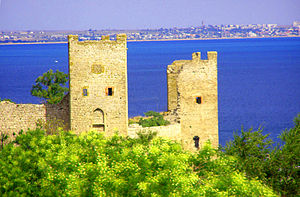The Siege of Caffa was a 14th century battle between Jani Beg's Golden Horde army and the city of Caffa, today Feodosia. The city was then part of Gazaria, a group of seven ports located in Crimea and belonging to the maritime empire of the Republic of Genoa.
| Siege of Caffa | |||||||
|---|---|---|---|---|---|---|---|
| Part of Genoese–Mongol Wars | |||||||
 The remains of a Genoese fortress in Feodosia | |||||||
| |||||||
| Belligerents | |||||||
|
| Golden Horde | ||||||
| Commanders and leaders | |||||||
|
Simone Boccanegra[a] (1345) Giovanni I di Murta[b] (1345–47) | Jani Beg[c] | ||||||
| Strength | |||||||
| Several thousand | Several thousand | ||||||
| Casualties and losses | |||||||
| Several thousand | Several thousand | ||||||
After two years of siege, the Mongol armies were forced to withdraw. The siege is famous for a story recounted by Italian notary Gabriel de Mussis, which attributed the subsequent spread of the Black Death to plague-infested corpses having been launched over the walls at the end of the siege.
Background
editCaffa was established by Genoese traders in 1266 by a purchase agreement with the Khan of the Golden Horde.[1][2]
Relations between the Genoese and the Mongol Golden Horde were strained. The khan of the Golden Horde, Toqta, was piqued at the Italian slave trade in Turkic slaves who were sold as soldiers to the Mamluk Sultanate. He arrested the Italian residents of Sarai (the Mongol capital), and besieged Caffa, which the Genoese resisted for a year, but in 1308 set fire to their city and abandoned it. Relations between the Italians and the Golden Horde remained tense until Toqta’s death in 1312.[3][4][2]
Toqtai’s successor, Özbeg Khan, mended relations with the Geneose, which allowed Caffa to become a thriving city once again by the 1340s.[5] However, the ascension of Özbeg Khan's son Jani Beg to the throne changed the political scene once more. The conversion of the Golden Horde Khans to Islam, led to them prosecuting Christians.
Siege
editThe Mongols under Jani Beg besieged Caffa in 1343 and the Venetian territory of Tana, the cause of which was a brawl between Italians and Muslims in Tana.[6] The siege of Caffa lasted until February 1344, when it was lifted after an Italian relief force killed 15,000 Mongol troops and destroyed their siege machines.
Jani Beg renewed the siege in 1345, and cut off any supplies to the city, leading to miserable conditions within Caffa. However, a serious epidemic of bubonic plague devastated his forces, giving hope to the Italians, and he was forced to lift the siege in 1347.[7] The siege and despair of the city's citizens as the disease spread is vividly described by the Italian notary Gabriel de Mussis.[8] However, de Mussis was not present at the siege and his story is contradicted by contemporary evidence from the Black Sea region. It is now believed that the Black Death spread to Europe in grain shipments that were restarted after the wartime embargoes between Venetian, Genoan, and Golden Horde merchants had been lifted.[9]
The Italians blockaded Mongol ports, forcing Jani Beg to negotiate for peace, and they were allowed to reestablish their colony in Tana in 1347.[4]
Notes
edit- ^ As the 1st Doge of the Republic of Genoa
- ^ As the 2nd Doge of the Republic of Genoa
- ^ As the Khan of the Golden Horde
References
edit- ^ Khvalkov, I.E., The Colonies of Genoa in the Black Sea Region: Evolution and Transformation,European University Institute,[1] Department of History and Civilization,Florence, 8 September 2015
- ^ a b Weapons of Mass Destruction: Nuclear weapons. ABC-CLIO. 2005. p. 173. ISBN 978-1-85109-490-5.
- ^ Balard, Michel; Veinstein, Gilles (1980). "Continuité ou changement d'un paysage urbain ? Caffa génoise et ottomane". Actes de la Société des Historiens Médiévistes de l'Enseignement Supérieur Public. 11: 79–131. doi:10.3406/shmes.1980.1361.
- ^ a b Grousset, René (1970). The Empire of the Steppes: A History of Central Asia. Rutgers University Press. ISBN 978-0-8135-1304-1.
- ^ Howorth, Sir Henry Hoyle (1880). History of the Mongols, from the 9th to the 19th Century ...: The Mongols of Persia. Longmans, Green, and Company.
- ^ Dols, MW. (1977). The Black Death in the Middle East. Princeton University Press.
- ^ "Decameron Web | Plague". www.brown.edu.
- ^ Wheelis, Mark (2002). "Biological Warfare at the 1346 Siege of Caffa". Emerging Infectious Diseases. 8 (9): 971–975. doi:10.3201/eid0809.010536. PMC 2732530. PMID 12194776. This article incorporates text from this source, which is in the public domain.
- ^ Barker, Hannah (2021-01-01). "Laying the Corpses to Rest: Grain, Embargoes, and Yersinia pestis in the Black Sea, 1346–48". Speculum. 96 (1): 97–126. doi:10.1086/711596. ISSN 0038-7134.